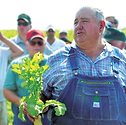Termination
Cover crops provide a multitude of agronomic and environmental benefits for growers, but In the end they're usually terminated ("killed") to provide nutrients back to the soil, increase carbon and soil organic matter and make room for cash crops — or become a highly nutritious food source for livestock. In this topic growers will find tips and strategies for ensuring the most efficient and effective termination of cover crops, whether it's by herbicide, winterkill, roller-crimper, mowing or other methods.
ARTICLES
Soil Health
With proper termination timing, cover crops benefit cash crops during dry years
Read More
Benchmark Survey
Cereal Rye, Post-Harvest Planting & Air Seeding Grow in Popularity
5th Annual Cover Crops Operational Practices Survey Asks Farmers About Cover Crop Management
Read More
Cover Crops
When Is the Best Time to Terminate Cereal Rye to Suppress Weeds & Protect No-Till Soybean Yield?
1st year of research shows that between 7-14 days after soybean emergence, rye increases weed suppression by 5.3% per day but hurts yield by about ½ bushel per day
Read More
Termination Options for Cover Crops & Winter Cereal Forages
Best management practices for terminating winter cereal forages and cover crops with pre-plant burndown programs.
Read More
Soil Health
Dave Brandt’s 5 Tips for Experienced Cover Croppers
Cover crop expert discusses his best practices for getting the most out of cover crops.
Read More








